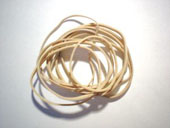
Purpose
To demonstrate how rubber material reacts when exposed to high levels of heat (rubber-band thermodynamics).
Additional information
Patented in Australia on March 17, 1845 by Stephen Perry, the rubber band has become an important part of our lives. We use rubber bands to organize papers, keep things shut tight, and for the occasional slingshot. Rubber bands originated from the sap of rubber trees, which are found mostly near the equator in humid climates. Most of the rubber bands today are made from synthetic materials, combining petroleum byproducts in a reactor with soapsuds to produce a milky liquid latex.
Entropy is a theoretical concept applied across physics, mathematics, and various branches of science. It's a way of measuring the amount of disorder in any given system. The thermodynamics of rubber bands is entirely entropy-driven.
Sponsored Links
Required materials
- Several large rubber bands
- Hair dryer
- A small toy or solid item that can be attached to the rubber band and that isn't made of rubber
- Doorknob or hook (such as a picture hook... something to hang the rubber band from)
- Tape measure
- Pen
- Journal (to record your results)
Estimated Experiment Time
Less than 15 minutes
Step-By-Step Procedure
- 1. Hang the rubber band on a doorknob or hook.
- 2. Attach the toy or small object to the rubber band (make sure it's not made of rubber). It should be attached in a manner that allows the item to "hang" from the band. At this point you should have a dangling object hanging from the middle of the band that's attached to the doorknob or hook.
- 3. Use the tape measurer to measure the distance from the floor to the bottom of the dangling toy or object. Record the result in your journal.
- 4. Carefully heat the rubber band with your hair dryer, making sure that the heat is focused on the rubber band as much as possible. This step shouldn't take too long, so be careful not to melt the band (or your dangling object).
- 5. Use your tape measure to once again measure the distance from the floor to the bottom of the dangling object. Record the results in your journal.
- 6. Compare the results from the first measurement against the results from the second measurement. Can you explain your findings? Were they what you expected?
Note
Needless to say, using the hair dryer on the rubber band will cause it (and everything around it) to get HOT! Take extreme care Whenever dealing with electricity or heat. If you're a younger scientist, you may want to get a parent or grownup involved.
Observation
Why do rubber bands contract when heated instead of expanding? Can you explain the phenomenon? What would happen if you hung the object with a piece of string? What about if you used a metal wire? Can you give some examples of real-life situations where heat can affect rubber objects? What about rubber tires on hot pavement in summer?
Result
The thermodynamics of rubber bands are most unusual. Unlike most materials, rubber shrinks when it's heated rather than expanding. When you stretch a rubber band, it gives off heat as the entropy goes down and the molecules become less disordered. When the band is relaxed it's entropy goes up as the molecules become more disordered. So, contraction of the rubber band is entropy-driven.
Sponsored Links
Take a moment to visit our table of Periodic Elements page where you can get an in-depth view of all the elements,
complete with the industry first side-by-side element comparisons!